The Banana is the oldest and commonest fruit known to humankind. It is one of the important fruits and constitutes the second-largest fruit industry in India. It is a nutritious palatable, and easily digestible fruit. It is available throughout the year. Banana contains carbohydrates and minerals such as calcium, potassium, Mg, Na, and phosphorous. Other than fresh fruits, they can be consumed as processed in various forms like chips, powder, flakes, etc.
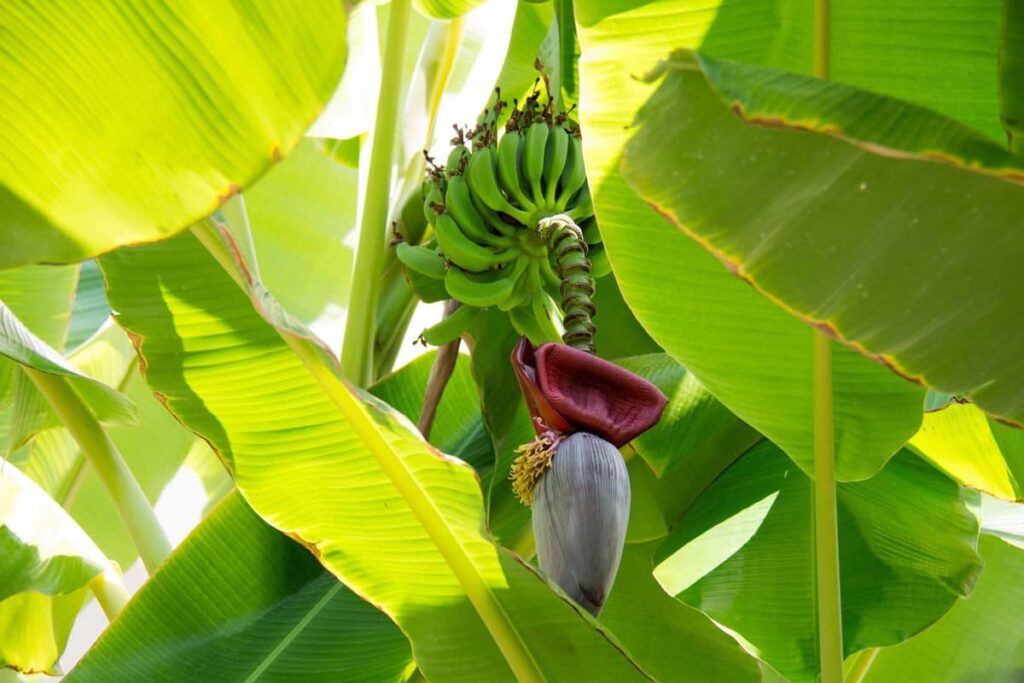
The Banana pseudostem is chopped and used as cattle feed. Also, the leaves are used as a plate. A total of 16.91 million tons are produced yearly from 12,20,000 acres, an average of 13.5 tons per acre nationally. With 24 tons/acre, Maharashtra leads the way in production. In India, bananas account for 37% of total fruit production.
Maharashtra ranks second in terms of area and first in terms of productivity in India. In most cases, bananas are grown by planting suckers. Jalgaon district of Maharashtra contributes around 70% of the state’s production and more than 11% of that of India. For this reason, it is known as the Banana hub of India or the Banana city of India.
Growing banana organically in Maharashtra
How does the Maharashtra government encourage organic farming?
The State Government has formulated a special policy for organic farming in the state. Per the policy, a separate cell will be created at the district level, which will monitor the growth of organic farming in the area. The government has also decided to support and create brands and help in promoting them. The policy has defined organic farming as an integrated method that uses local natural resources for farming and rejects using chemicals for cultivation.
This scheme encourages farmers to use organic inputs to improve the soil fertility rate, certify the organic agricultural area, sell organic products, brand organic agricultural products and promote organic farming. The Maharashtra government is also promoting the production of organic crops, fruits, vegetables, etc., through various central government schemes viz National Horticulture Mission (NHM), Rashtriya Krishi Vikas Yojana (RKVY), National Project on Organic Farming (NPOF), Network Project on Organic Farming under Indian Council of Agricultural Research (ICAR), etc.
In case you missed it: Red Banana Farming in India: How to Start, Cultivation Practices, and Panting to Harvesting Guide
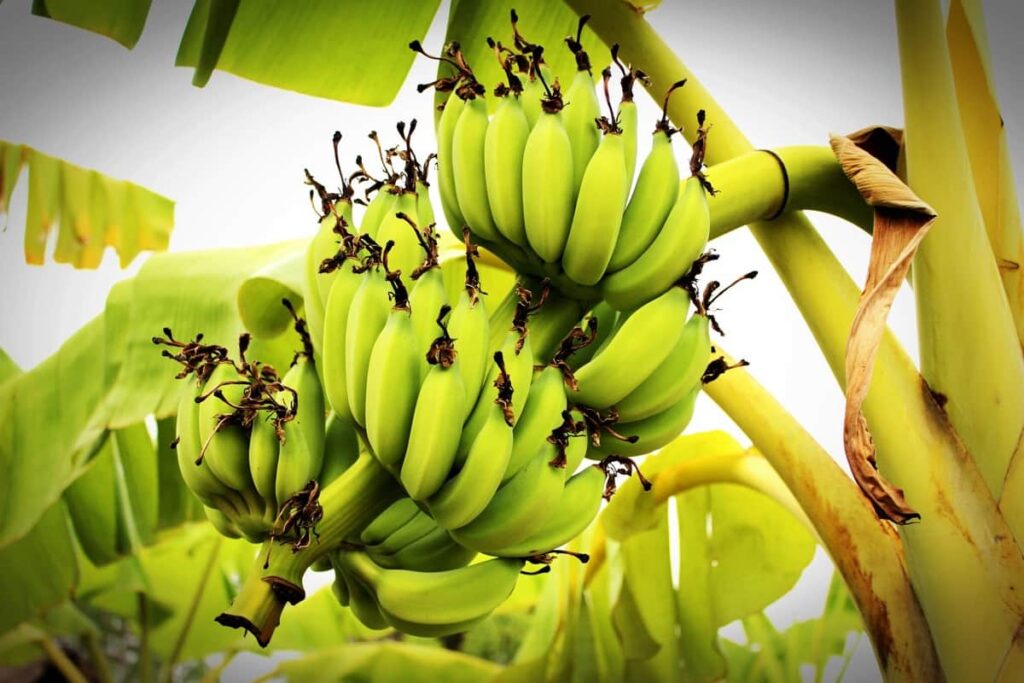
Banana varieties growing in Maharashtra
Table varieties
| Monsmarie | Karpooravalli |
| Robusta, Grand Naine | Poomkalli |
| Dwarf Cavendish | Koompillakannan |
| Chenkadali | Chinali |
| Poovan | Dudhsagar |
| Palayankodan | BRS-1 |
| Njalipoovan | BRS-2 |
| Grosmichel | Poovan and Red Banana |
Culinary varieties
| Monthan | Kanchikela |
| Batheesa | Nendrapadathy |
Climate condition for organic Banana farming
The Banana grows well in a temperature range of 13°C to 38°C with an RH regime of 75-85%. Through the use of appropriate varieties like Grandnaine, this crop is cultivated in climates ranging from humid tropical to dry mild subtropical.
Injuries caused by chilling occur at temperatures below 12°C. In the Banana plant, normal growth occurs between 18°C and 27°C, then declines until 38°C, at which point the plant ceases to grow. Sunburn occurs when the temperature is high. Additionally, high-velocity winds that exceed 80 km per hour damage the crops.
Soil requirements for organic Banana farming
Bananas require good drainage, fertility, and moisture in their soil. The best soil for banana cultivation is deep, rich loamy soil with a pH between 6 and 7.5. Poorly drained, poorly aerated, and nutritionally deficient soils should not be used for banana cultivation. Soil that is saline, solid, and calcareous is not suitable for banana cultivation. It was best to avoid low-lying areas, very sandy soil, and heavy black cotton with poor drainage. The best banana soil is not too acidic and alkaline, rich in organic material, and contains plenty of nitrogen, phosphorus, and potash.
Land Preparation for organic Banana farming
In preparation for planting bananas, plant a green manuring crop such as daincha, cowpea, etc., and bury them in the soil. Then, a 2-4-time plowing and leveling can be done on the land. Rotavators or plows can break up the clods and tilt the soil finely. A base dose of farm yard manure is added to the soil during soil preparation.
It is usually necessary to dig a pit that is 45 cm x 45 cm x 45 cm. In addition to topsoil, 10 kg of farm yard manure (well decomposed) and 250 gm of Neem cake will fill the pits. When prepared pits are exposed to solar radiation, harmful insects are killed, soil-borne diseases are prevented, and aeration is improved. The Pit mixture should be modified to incorporate organic matter in saline-alkali soils with a pH above 8.
In case you missed it: High Yield Hybrid Banana Varieties in India: State Wise Guide
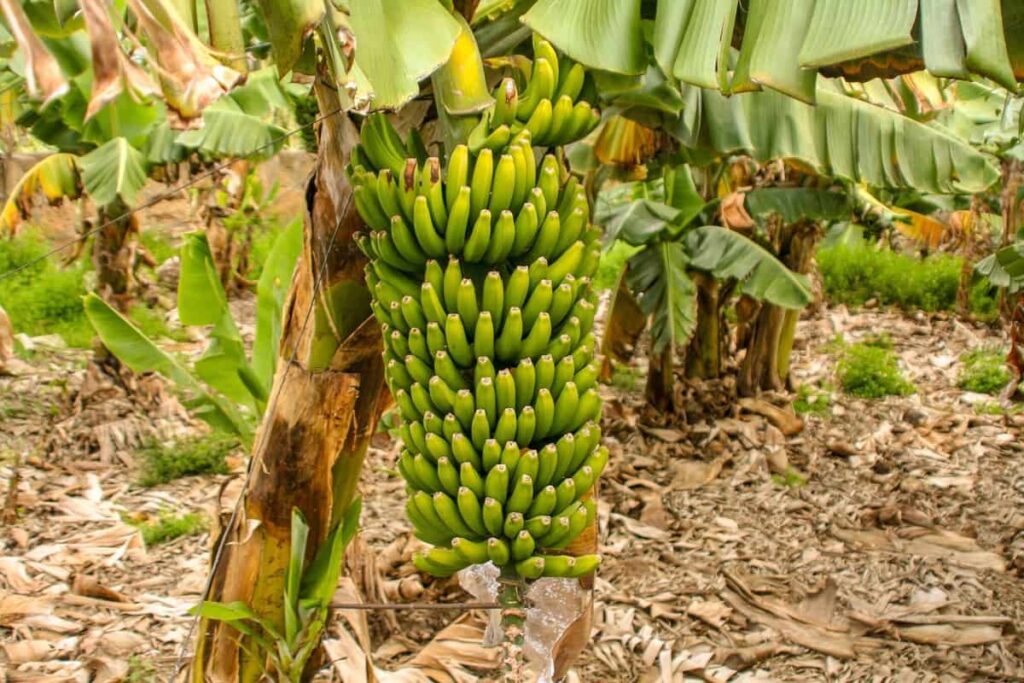
Selection of suckers
Choose 3-4-month-old disease-free sword suckers from healthy clumps. After the bunch is harvested, suckers should be removed one week later. For the Nendran variety, remove the old roots and cut the pseudostem to 15-20 cm from the corm. Rhizome weevil (black tunnels) and nematode (darkened lesions) infected corms and roots should be removed.
Rhizomes should be dipped in hot water (50°C) for 20 minutes to prevent nematode infestations. Then, the rhizomes should be smeared with cow dung solution and ash, dried in the sun for about 3-4 days, and stored in the shade for up to 15 days before planting. The suckers should also be soaked in Pseudomonas fluorescens solution (2%) for 30 minutes before planting.
Planting and infilling for organic Banana farming
The time of planting Bananas depends solely on climatic conditions and the availability of water. In areas of heavy and continuous rains, planting of bananas should be done after rains, i.e., September – October, and in those where rains are not so heavy, planting can be done in June-July. In Irrigated areas, the planting is done in February – March, and in hilly areas in April.
The planting material is treated with 250 g of ghee, 0.500 g of honey, and 15 kg of cow dung. Pair row planting at 0.9 m X 1.5 m X 2.1 m is also recommended in Maharashtra. It also accommodates the 1750 plants/acre. Farmers from western Maharashtra also adopt 1.5 m X 1.8 m, 1.8 m X 1.8 m, or 1.8 m X 2.1 m spacing.
Irrigation for organic Banana farming
For bananas to be productive, they need a large quantity of water. Bananas are succulents, evergreens, and shallow-rooted crops. Water requirements for bananas have been calculated to be 1,800 – 2,000 mm per year. Irrigation should be provided for 4-5 days in summer and 7-8 days in winter. During the rainy season, irrigation is provided if needed, as excess irrigation may remove air from soil pores, affecting the establishment and growth of plants.
There are 70-75 irrigations provided to the crop in total. An effective irrigation system, such as drip irrigation, is essential for banana production. Trench, furrow, and basin systems are followed. Water use efficiency has been improved through drip irrigation and mulching technology. Under drip irrigation, water is saved by 58%, and yields are increased by 23-32%.
Manure application in organic Banana farming
Fifteen tons of farm yard manure/compost are applied during land preparation. Following plantation, farmyard manure is applied at 5 kg per plant, Bhumilab at 2 kg per plant, Trichoderma at 20 grams, and humus at 30-50 ml per plant for the first year, and farmyard manure at 10 kg for the next two years. Jeevamrut and Gomutra (cow urine) are also sprayed. In 200 liters of water, mix 10 kg cow dung, 5 liters of cow urine, 2 kg black jaggery, 2 kg ground pulses powder, and a handful of bund soil, then ferment it for two to seven days in the shade.
In case you missed it: 20 Key Rules for Setting Up a Budget Hydroponic Garden at Home
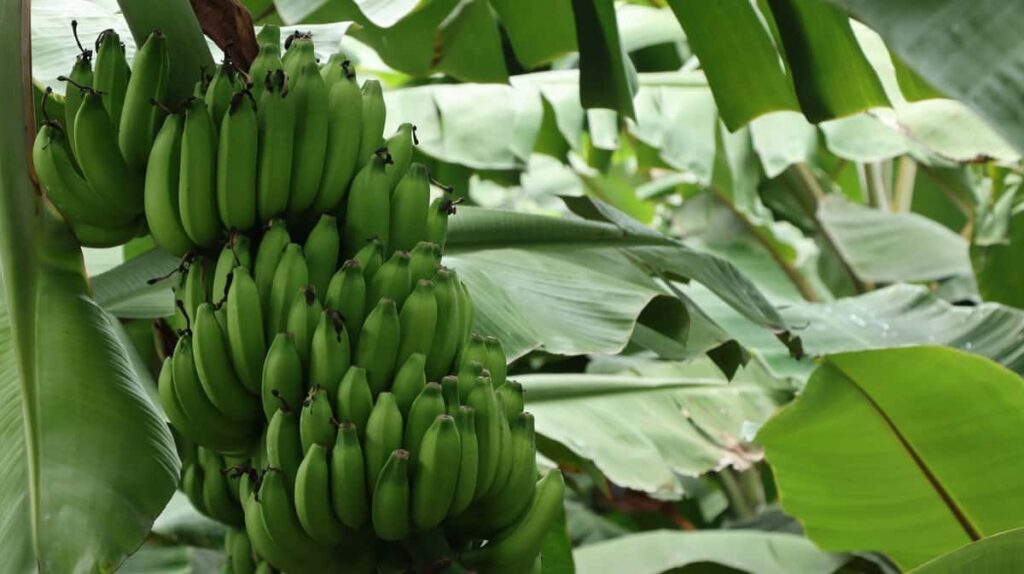
The solution is stirred daily during fermentation. As a foliar spray, Panchagavya 3% can be applied thrice after planting, at the 3rd, 6th, and 9th months. Plant sunnhemp / daincha / cowpea after planting bananas at a seed rate of 20 kg per acre (20 grams per plant). The green manure crop should be sown 40 days after the original sowing again and incorporated into the soil. Potassium is abundant in compost made from banana leaves and bunch stalks.
Desuckering
After planting, bananas throw suckers between 2-3 months. These suckers should not be allowed to grow as they compete for water and nutrients with the mother plants, reducing the main crop’s yield. A sickle should be used to desucker every 15-20 days from the beginning until flowering. It is essential to wrap the bunches to ensure that the fruits have no blemishes or bruises and that the size and quality are uniform. It is possible to cover the fruits with black-colored polyethylene for this purpose.
Major pests in Banana and their organic control
Nematodes
Damage symptoms
- Stunting of plants
- Reduction in size and the number of leaves and bunch weight
- The appearance of a dark red lesion on the roots.
- The toppling of plants in windstorms or heavy rains.
Control and management
- Pare the rhizomes and dip them in hot water at 45-50°C for 20 minutes will control nematodes.
- Apply neem cake at 1kg/plant at the time of planting.
- Intercrop Banana with sunn hemp or marigold to reduce nematode population.
Banana Rhizome Weevil
Damage symptoms
- Grubs bore into the rhizome and cause the death of the plant.
- Presence of dark-colored tunnels in the rhizomes.
- Death of unopened pipe, withering of outer leaves.
Control and management
- Make sure your planting material is healthy and pest-free.
- Remove old rhizomes from the soil and expose the inner soil layer to the sun by deep plowing.
- Suckers should be dipped in cow dung slurry and then aired out.
- Keep split pseudostems in the field to attract adult weevils. You should then collect the adult weevils each day and destroy them.
- One kilogram of crushed neem seed should be applied per plant to the pit.
In case you missed it: How to Fertilize Avocado Trees For Insane Fruit Set: Schedule for Natural, Organic, and Chemical Application
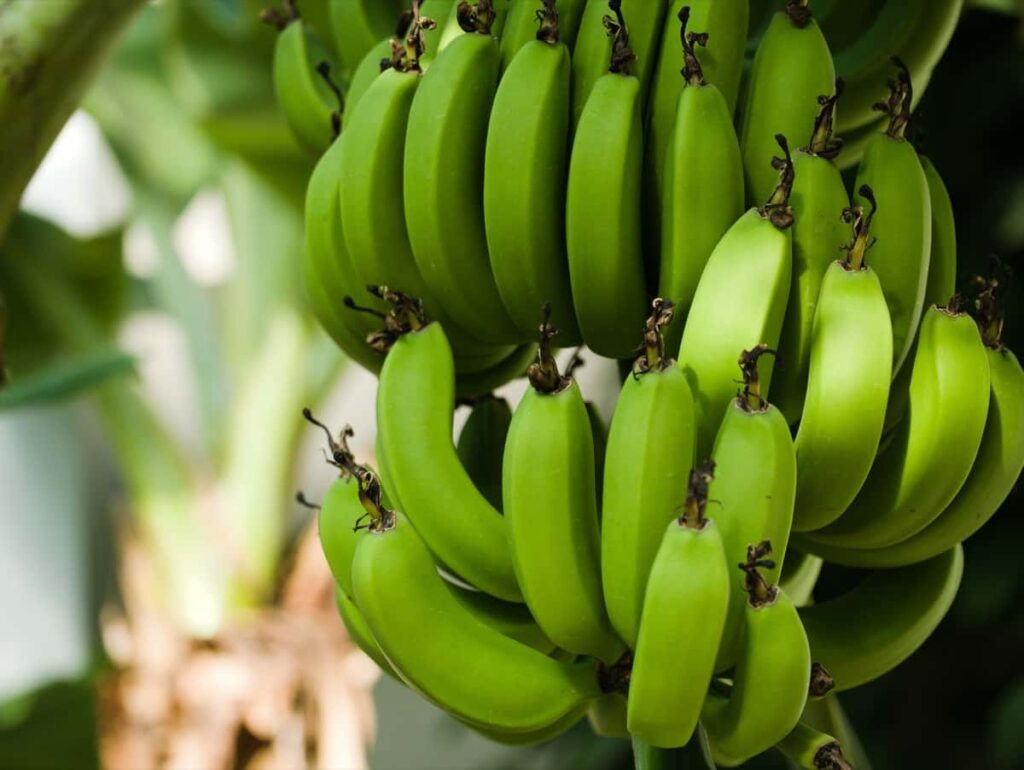
Banana pseudostem weevil
Damage symptoms
- A brownish larval frass can also be seen around the holes.
- A yellowing of the leaves and stunting of plant growth can occur.
- During windy weather or storms, plants can break and fall over when the stem is weakened due to serious infections.
- Wounds infected with opportunistic pathogens rapidly discolor and emit foul odors.
Control and management
- Infested plants with rhizomes should be removed and burned if they are severely infested.
- The loose and dry sheaths of the pseudostem of plants should be removed from the 5th month onwards.
- Mix neem oil emulsion at 3% in the mud slurry (30 ml/liter) used for swabbing around the pseudostem if the infestation is noticed.
Major diseases in banana farming and their organic control
Sigatoka leaf spot
Disease symptoms
- Leaves show elliptical spots that turn light gray at their center and have a yellow halo around them.
- A large irregular patch of dried tissue often forms as a result of the spots coalescing.
- A characteristic feature of this disease is the rapid drying and defoliation of leaves.
Control
- Cut and burn all severely affected leaves.
- Need-based sprayings are to be given depending on the severity of the disease.
- Power oil (Mineral oil) 1 % emulsion effectively controls the disease.
- Bioagents like Pseudomonas fluorescens 20 grams/liter (2%) or Bacillus subtilis 5 grams /liter are effective against Sigatoka leaf spot disease.
- Grow resistant/less susceptible varieties such as BRS-1, BRS-2, and Dudhsagar. Among Nendran, the selection of Manjeri Nendran II is the least susceptible.
Panama Wilt
Disease symptoms
- Wilting and light yellow coloring of the lower leaves, most prominent around the margins. They eventually turn a bright yellow color with dead leaf margins.
- Splitting of the pseudostem base is a characteristic symptom.
- As symptoms progress into the pseudostem, continuous lines of discoloration are evident when the plant is cut longitudinally.
Control
- The affected clumps and corms should be removed and destroyed.
- Lime should be applied at a rate of 500 grams per pit and allowed to weather.
- When planting, apply 1 kg of neem cake per pit and water them well.
- The disease is less prevalent in varieties such as Palayankodan, Robusta, and Nendran.
- Before planting, dip the planting material in 2% Pseudomonas.
Banana Bract Mosaic Disease
Damage symptoms
- The pseudostem, midrib, and peduncle display pinkish-reddish streaks in the shape of spindles
- Typical mosaic and spindle-shaped mild mosaic streaks were also observed on bracts, peduncles, and fingers.
- Reddish brown streaks appear at emergence, and the leaf sheath separates from the central axis in suckers.
- Its characteristic symptom is a cluster of leaves at the crown, an elongated peduncle, and half-filled hands.
In case you missed it: Growing Onions Organically in Maharashtra: Cultivation Practices and Production Management
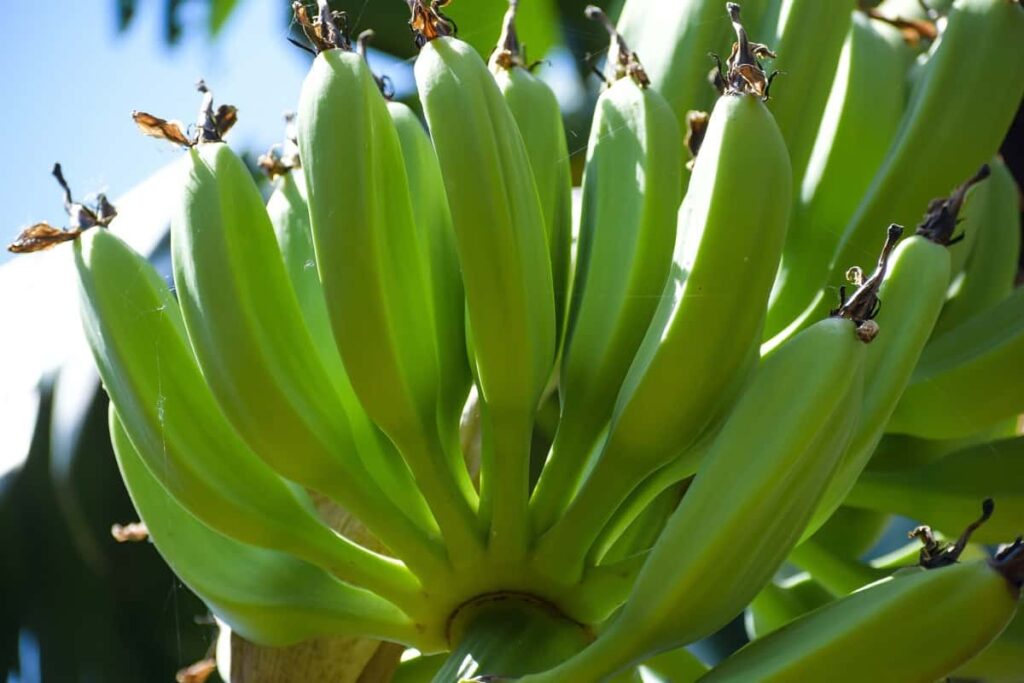
Control
- Use disease-free healthy suckers for planting.
- Eradicate disease-affected plants as and when noticed.
- Spray neem-based organic insecticide to control the vector.
Harvesting Banana crop
After planting, banana plants usually produce fruit 15-18 months later. Bananas are harvested when they are still green, not when they are yellow. Fruit fingers get fatter as they mature, but they remain green. You can harvest your fruit in 4-6 weeks when the fingers stop growing. Whenever bananas are well-rounded between the ribs and the little flowers at the end are dry, they are ready for picking. When cutting bananas, it is best to remove the entire stalk.
Put your banana stalk in a shady spot to finish ripening. From green to yellow, they usually ripen from top to bottom. A total of three crops can be harvested over 28-30 months, namely one main crop and two ratoon crops. A yield of 40 tons/acre of bananas can be achieved using the tissue culture technique under drip irrigation and fertilization; even a similar yield can be obtained in ratoon crops if the crop is managed correctly.
Conclusion
Banana farming organically is becoming increasingly popular. A few simple steps are involved in banana cultivation, but good management practices are needed to make a good profit. People are interested in banana farming because, in recent decades, it has become a common trend to have farms for food crops, poultry, or livestock because of its high-profit margins. If you live in the following districts of Maharashtra and planning to start organic banana farming, this guide will help you.
| Ahmednagar | Nagpur |
| Akola | Nanded |
| Amravati | Nandurbar |
| Aurangabad | Nashik |
| Beed | Osmanabad |
| Bhandara | Palghar |
| Buldhana | Parbhani |
| Chandrapur | Pune |
| Dhule | Raigad |
| Gadchiroli | Ratnagiri |
| Gondia | Sangli |
| Hingoli | Satara |
| Jalgaon | Sindhudurg |
| Jalna | Solapur |
| Kolhapur | Thane |
| Latur | Wardha |
| Mumbai City | Washim |
| Mumbai Suburban | Yavatmal |
- How to Raise Pigs in Your Own Backyard: A Comprehensive Guide
- Budget Friendly Sheep Shed Ideas: Cheap and Low-Cost Tips
- How Much Do Cattle Farmers Make: Revenue Streams in Cattle Farming
- Management Pests and Diseases in Your Cotton Field
- Sheep Farming Business Plan for Beginners
- Aquaponic Farming at Home: A Step-By-Step Guide
- Profitable Village Farming Business Ideas in 2024
- High-Yield Aquaculture: Fast-Growing Fish for Farming
- Effective Fish Pond Construction Techniques for Beginners
- Irrigation and Water Management in Pineapple Farming
- Blossom to Harvest: Mastering Flowering and Pollination in Papaya Farming
- Pig Fattening Essentials: From Selection to Sale for Beginners
- Raising Wagyu Cattle: A Complete Guide for Premium Beef Production
- Soil Types and Their Water Holding Capacity
- Optimizing Irrigation Schedules for Coconut Groves for Enhanced Yield
- Espresso Your Garden: Coffee Grounds for Healthier Acid-Loving Plants
- The Best Soil Mix for Snake Plants: How to Mix Your Own Snake Plant Soil
- Green Thumb Success: Expert Tips for Cultivating Greenhouse Beans All Year Round
- Bloom All Year Round: The Ultimate Guide to Indoor Hyacinth Care
- Eco-Friendly Gardening: How to Make Liquid Fertilizer from Kitchen Waste
- Ultimate Guide to Grow Anise in Pots: Explore Seed Propagation to Harvesting
- Guide to Raising Chester White Pigs: Discover Breed Facts to Growth Management
- Mastering the Elegance: The Ultimate Guide to Weeping Cherry Tree Care, Planting, and Maintenance
- Ultimate Guide to Planting Garlic in Grow Bags: Growing Strategies for Beginners
- How to Fix Spider Plant Leaf-Related Problems: Natural and Organic Remedies
- 10 Reasons Why Your Tulsi Plant is Shedding Leaves: Home Remedies and Solutions
- Optimizing Growth and Yield: The Advantages of Palm Bunch Ash Fertilizer
- Utilizing Neem Oil Extract as a Natural Pesticide for Hydrangea
- From Soil to Harvest: Various Ways in Which Farmers Can Use AI Tools
- Steps to Encourage and Induce Citrus Flowers: A Comprehensive Guide
- How to Fix Snake Plant Leaf-Related Issues: Natural and Organic Remedies
- Transform Your Garden into a Fragrant Oasis with Raat Ki Rani (Night Blooming Jasmine)
- Discover the Ideal Chicken Breeds for Philippine Farms
- How to Create a Poultry Egg Farm Business Plan for Profits
- Grow Lemon Cucumbers Like a Pro: Insider Techniques for Bountiful Yields
- Ultimate Guide to Caring for Your Pink Princess Philodendron: Tips for Thriving Variegation

I would be interested in organic banana farming, appreciate if you could guide or send me links, YouTube